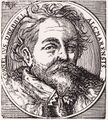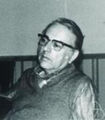Template:Selected anniversaries/December 5: Difference between revisions
No edit summary |
No edit summary |
||
| Line 4: | Line 4: | ||
File:Cornelius Drebbel.jpg|link=Cornelius Drebbel (nonfiction)|1601: After weeks at of hunting at sea, submarine inventor [[Cornelius Drebbel (nonfiction)|Cornelius Drebbel]] locates the marine cryptid and alleged supervillain [[Neptune Slaughter]]. The resulting battle will permanently drive Neptune Slaughter from Dutch waters, but at the cost of more than half of Drebbel's crew. | File:Cornelius Drebbel.jpg|link=Cornelius Drebbel (nonfiction)|1601: After weeks at of hunting at sea, submarine inventor [[Cornelius Drebbel (nonfiction)|Cornelius Drebbel]] locates the marine cryptid and alleged supervillain [[Neptune Slaughter]]. The resulting battle will permanently drive Neptune Slaughter from Dutch waters, but at the cost of more than half of Drebbel's crew. | ||
||1624: Gaspard Bauhin dies ... botanist and physician. | ||1624: Gaspard Bauhin dies ... botanist and physician. Pic. | ||
File:Seki Takakazu.jpg|link=Seki Takakazu (nonfiction)|1708: Mathematician [[Seki Takakazu (nonfiction)|Seki Takakazu]] dies. He created a new algebraic notation system and, motivated by astronomical computations, did work on infinitesimal calculus and Diophantine equations. Seki laid foundations for the subsequent development of Japanese mathematics known as ''[[Wasan (nonfiction)|wasan]]''; he has been described as "Japan's Newton". | File:Seki Takakazu.jpg|link=Seki Takakazu (nonfiction)|1708: Mathematician [[Seki Takakazu (nonfiction)|Seki Takakazu]] dies. He created a new algebraic notation system and, motivated by astronomical computations, did work on infinitesimal calculus and Diophantine equations. Seki laid foundations for the subsequent development of Japanese mathematics known as ''[[Wasan (nonfiction)|wasan]]''; he has been described as "Japan's Newton". | ||
| Line 99: | Line 99: | ||
||1998: Hazel Bishop dies ... chemist and cosmetic executive who made an indelible mark on the cosmetics industry by inventing non-smear ("stays on you not on him") kissproof lipstick. During WW II, as senior organic chemist with Standard Oil, she discovered the cause of deposits affecting superchargers of aircraft engines. She never married. In 1949, after a long series of home experiments, in a kitchen fitted out as a laboratory, she perfected a lipstick that stayed on the lips longer than any other product then available, and began its manufacture. It was introduced at $1 a tube in the summer of the following year. In 1951, a partner forced her out of the $10 million company she created. Pic. | ||1998: Hazel Bishop dies ... chemist and cosmetic executive who made an indelible mark on the cosmetics industry by inventing non-smear ("stays on you not on him") kissproof lipstick. During WW II, as senior organic chemist with Standard Oil, she discovered the cause of deposits affecting superchargers of aircraft engines. She never married. In 1949, after a long series of home experiments, in a kitchen fitted out as a laboratory, she perfected a lipstick that stayed on the lips longer than any other product then available, and began its manufacture. It was introduced at $1 a tube in the summer of the following year. In 1951, a partner forced her out of the $10 million company she created. Pic. | ||
||1998: John Lions dies ... computer scientist and academic. He is best known as the author of Lions' Commentary on UNIX 6th Edition, with Source Code, commonly known as the Lions Book. Pic. | |||
File:Nathan Jacobson.jpg|link=Nathan Jacobson (nonfiction)|1999: Mathematician [[Nathan Jacobson (nonfiction)|Nathan Jacobson]] dies. He conducted research on the structure theory of rings without finiteness conditions--a subject closely related to the theory of algebras--which transformed the approach to classical results and broke ground for solutions to problems inaccessible by previous methods. | File:Nathan Jacobson.jpg|link=Nathan Jacobson (nonfiction)|1999: Mathematician [[Nathan Jacobson (nonfiction)|Nathan Jacobson]] dies. He conducted research on the structure theory of rings without finiteness conditions--a subject closely related to the theory of algebras--which transformed the approach to classical results and broke ground for solutions to problems inaccessible by previous methods. | ||
Revision as of 16:26, 31 March 2019
1601: After weeks at of hunting at sea, submarine inventor Cornelius Drebbel locates the marine cryptid and alleged supervillain Neptune Slaughter. The resulting battle will permanently drive Neptune Slaughter from Dutch waters, but at the cost of more than half of Drebbel's crew.
1708: Mathematician Seki Takakazu dies. He created a new algebraic notation system and, motivated by astronomical computations, did work on infinitesimal calculus and Diophantine equations. Seki laid foundations for the subsequent development of Japanese mathematics known as wasan; he has been described as "Japan's Newton".
1772: Astronomer and mathematician Nicole-Reine Lepaute publishes new class of Gnomon algorithm functions which detect and prevent crimes against astronomical constants.
1872: The crewless American ship Mary Celeste is found by the Canadian brig Dei Gratia. The ship had been abandoned for nine days but was only slightly damaged.
1873: Newly discovered illustration of The Eel fighting Neptune Slaughter is "almost certainly a record of events related to the abandonment of Mary Celeste," says math photographer Cantor Parabola.
1901: Physicist and academic Werner Heisenberg born. He will introduce the uncertainty principle -- in quantum mechanics, any of a variety of mathematical inequalities asserting a fundamental limit to the precision with which certain pairs of physical properties of a particle can be known.
1923: Photograph says it captured moment of Evil bit release.
1932: German-born Swiss physicist Albert Einstein is granted an American visa.
1964: Color commentators announce formation of Color Commentator's Union.
1966: George Plimpton embeds himself within Color Commentator's Union as participatory journalist.
1999: Mathematician Nathan Jacobson dies. He conducted research on the structure theory of rings without finiteness conditions--a subject closely related to the theory of algebras--which transformed the approach to classical results and broke ground for solutions to problems inaccessible by previous methods.
2008: Chemist and composer George Brecht dies. He was an American conceptual artist and avant-garde composer, as well as a professional chemist who worked as a consultant for companies including Pfizer, Johnson & Johnson, and Mobil Oil.
2018: Confessions of a Quantum Artist-Engineer voted Publication of the Day by the citizens of New Minneapolis, Canada.












